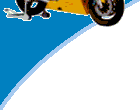



![]()
In addition to the model kits and glue, you will need some basic tools for building models. Also, over time you will find yourself buying tools for specific modelling tasks. I've categorized the tools that I have acquired to making modelling easier, more enjoyable and safer.
![]()
Getting Started ![]()
To start in the modelling hobby, you really don't need many special tools.
Other than the kit and paints, the only other things you need before you start a
kit are:
- Cement - if you've ever been in a toy store or department store that carries models, you've probably seen the Testor's tube of glue. It does the job, but can be quite messy and you can easily mar the parts. A much better cement to use is a liquid cement. It will come in a bottle like paint does and is available in different consistencies. You apply this cement with a provided brush or a paint brush. I'd recommend that you should forget the tube of cement and use a liquid cement to build much cleaner models. You'll need to visit a hobby shop to get this type of cement. I like Tamiya's cements, but there are other brands.
- Modelling Knife - There are a variety of styles. Some with a
single blade (X-Acto knife) and others with a snap off blade (OLFA). You can find a suitable knife
at the hardware store or a hobby store.
Note: These should only be used by older modellers as they are VERY sharp. - Side Cutters - you should never pull or twist off the kit parts. Use a pair of side cutters to remove the parts and then use a modelling knife and sandpaper to clean up were the part was removed. You can find side cutters at any hardware or electronics store. I bought mine at Radio Shack.
- Sandpaper - also can very useful for cleaning up parts once removed from the sprue trees. Look for 400 and 600 grit wet/dry sandpaper in the hardware or automotive store.
- Tweezers - can be very useful for holding and positioning small parts. Tweezers with an angled tip are better when used for placing parts. Your local pharmacy will have a varied of tweezers in the cosmetics isle.
And that's it for getting started. As your interest in the hobby grows, you'll find other tools mentioned in my workshop pages.
![]()
- Note: ALL tools are potentially dangerous. After all a tool is used for cutting and scraping materials. So as This Old House's Norm Abram would say "Always check and follow manufacture's safety recommendations. And always wear the most important safety item, your safety glasses".
- This is a hobby and it should give you pleasure, not pain. Don't use a tool for a job it wasn't designed for.
- This is also a hobby where hazardous materials are used. Things such and glue,
paint, etc. must be used as directed to minimize any chance of being harmed. Please read
product labels, especially those bearing this symbol:

|
|||||||||||||||
 Home - News - Tips - Gallery - Workshop - Kits - Links - What's New? - Site Index |